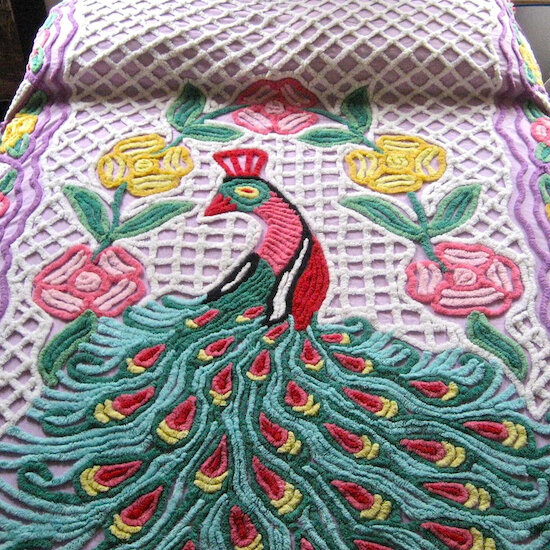I love chenille bedspreads and I could probably write a book on them. I sell a few in my Etsy shop and want to pass along a few words of advice to those who are new to the wonderful world of chenille.
If you buy your spread from me, it will be clean and ready for use, but if get your spread from an estate or other situation where it is dirty or smelly (ew!), you might want to give it a good cleaning. In case you are new to chenille, I thought I'd pass along a few tips:
Before you start
Chenille spread before washing—looks pretty dingy, the tufting should be white, not yellow-ish—but otherwise, no holes or tears.
First, take a good look at the ground cloth of the spread. Most use a heavy cotton sheeting as the ground (some are on a gauzier cotton, or a satin), but countless washings over the decades sometimes leave the fabric very thin--and thin equals weak, which means you have to use extreme care in the cleaning process. Similarly, even tiny pin holes in the fabric can become big tears if the spread is handled in the wrong way. Best to be aware of any and all condition issues before you begin.
The small hole you see at the center will probably be fine when washing, but it’s smart to keep an eye on it and treat that area with extra care.
Soaking
I soak spreads before washing them. This helps get rid of any stains and general dinginess. I fill a big tub with hot, hot water and a double dose of Oxi-Clean or other such deep cleaner (Biz is great, too).
This is a 58-quart storage bin filled with water and Oxi-Clean. I fill it with water about half way—the spread will take up space, and you need a bit of room to swish things around.
Stir the Oxi into the water to dissolve it as much as possible. Dissolving the Oxi-Clean is especially important with colored spreads, because it can bleach tiny white spots into the ground cloth if you are not careful. Push the spread into the water.
Gently squish the water through the spread. If you are using your bathtub, you might have the space to gently stir the whole thing, but be careful. Wet textiles are extremely heavy and if you tug on them, you run the risk of tearing the fabric. I will roll the whole spread over in the tub so that the part that started on the bottom gets rotated to the top
I usually wear rubber gloves when I do this—the water is hot and the Oxi-Clean is rough on your skin. I don’t claw at the spread with my fingers but try to keep my hands flat like paddles as I lift it from underneath to turn it in the water. Don’t get clever and use a big spoon or brush—with your hands you get a better feel for what you are doing.
Soak it. I will generally let the spread sit at least until the water cools, or even overnight. I’ve never done any damage to a cotton by letting it soak for a good long time. I’ll push the spread back down into the water just to make sure it stays wet.
This water has turned a little brown, but I’ve soaked spreads where the water turns opaque… Still, this one will sit overnight, the water will be emptied, then it will get soaked again in a fresh batch of Oxi.
The water might turn brown and smelly (again, eww, this is often from cigarette smoke), in which case you might want to dump the water out of the tub and start again with fresh water and Oxi.
Once you’ve soaked to your heart’s content, drain the water and gently squish out as much of the Oxi water as possible. Again, take care not to manhandle your soggy spread. This is one reason I often use a tub instead of my bathtub—I keep it on the kitchen counter near the sink so that I can either tip it into the sink to drain it (easier with two people—one tips the tub, the other holds the spread from falling into the sink while the water drains out), or use a pot to empty out water until it is light enough to do so. Then you can more easily carry the tub with the still-soggy spread to the washing machine without dripping all over the place. I give the spread a gentle wash to get out the rest of the Oxi-Clean.
**A special word about rust spots--similar to the rust on your car, these orange-y brown spots on fabrics can be ruinous to your old textiles and will burn right through the fibers. Scrubbing at rust spots can easily lead to holes. Proceed with extreme caution.
Coral leaves and white squares, circa 1950.
General Care and Laundering
Chenille bedspreads are all cotton, and can be laundered pretty much the same way your other cotton items are. I generally use a detergent that specifies that it prevents colors from fading (I like Woolite Extra Dark Care for colors), just to give a bit of added protection. Using warm water in the gentle cycle of your washing machine is a good idea, and preferably use a machine without an agitator at the center.
As I said, chenilles are very heavy when wet, so take care to handle gently when removing yours from the washing machine. Try to support the whole spread (really get your arms under the whole thing) instead of picking it up from one corner and tugging it out of the machine--you don't want to tear it! Sadly, I know this from personal experience. Once I tore a lovely handmade chenille by not paying attention and yanking on a corner to get it out of the washer.
Detail of a ring pattern in blue and white—this pattern comes in several different colorways.
Though I seldom use it otherwise, chenilles really benefit from using a liquid fabric softener (like Downy) in the wash. Dryer sheets don't seem to work as well (and they have nasty chemicals in them). Super soft results.
Line drying is better for the planet, and the original care instructions on some chenilles specify 'hang evenly on a line to dry...just shake briskly once or twice while drying to fluff the tufting.' The dryer, though, will give fast and fluffy results!

Original Cabin Crafts paper tag with care instructions.
But...over time, repeated trips through the washer and dryer will thin your spread, much the way it works on a pair of jeans. It's a little horrifying to see the amount of fluff in the lint trap after drying a chenille bedspread! I keep my chenilles and other bedspreads in rotation so I don't end up washing the same one over and over.
You can also put a dry chenille into the dryer for 10-15 minutes to freshen it up, without running it through the wash.

Storage
Most cotton textiles are best kept in a cool, dry, dark place. Light is a foe to all textiles.
Don’t store your spread in a plastic bag or bin. Textiles need to breathe.
Every time you store your vintage spread, fold it a different way. If you fold it in half along the length, then half way along the width every time, that center point where the two folds meet can start to show wear. Mix it up and fold it into thirds, or don’t fold it exactly in half so that the crease is in a different place every time.
If I were craftier, I would make big storage bags out of unbleached muslin for each of my spreads--with a drawstring and a tag to identify it. This will keep the light and dust off of them. But I am not so crafty, so I take the lazy way out and often just wrap them in lengths of muslin that I haven’t sewn.
Hope this is useful! If you have any other questions about chenilles, feel free to be in touch with me. Enjoy.
I’m always looking to buy old chenille bedspreads, either individual pieces or entire collections. Be in touch with me here if you’d like to discuss selling yours.
You can see more chenilles in my post on all-white summer spreads here.

Brown chenille bedspread with loopy circles
© All text and images are copyright of Jeni Sandberg












